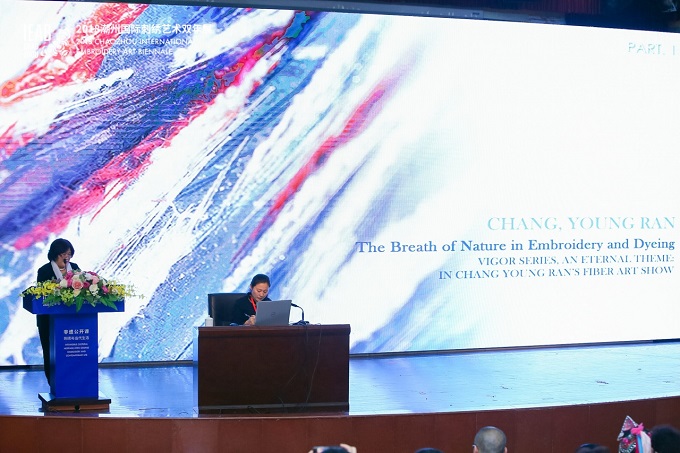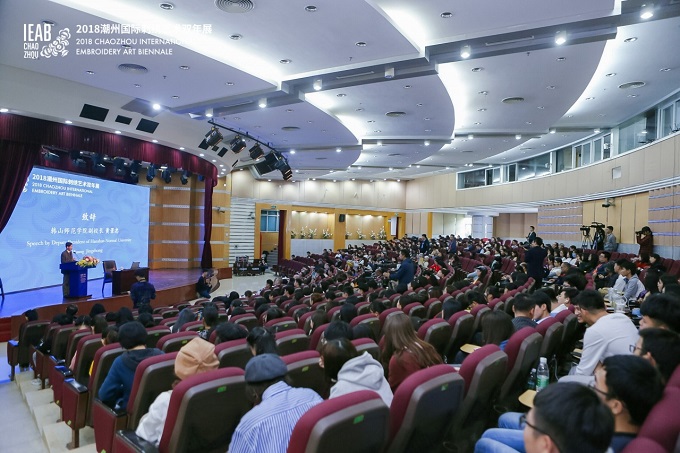Focusing on textile intangible cultural heritage to promote cultural confidence
The Intangible Cultural Heritage Open Class of the Biennale was held in Chaozhou
Dec 28, 2018 | by Flora

In the afternoon of Dec. 20th, 2018, the Intangible Cultural Heritage Open Class of the Biennale was held at the International Conference Center of Hanshan Normal University in Chaozhou, Guangdong. The Open Class invited domestic and foreign embroidery artists from the embroidery industry as well as industry stakeholders to discuss the theme of this Biennale “Embroidery and Contemporary Life”.
With the expansion of China’s opening up to the outside world and the deepening of international cultural exchanges and cooperation, the exchange of Chinese embroidery and embroidery culture and skills from all over the world has shown a trend of mutual learning, mutual improvement and mutual absorbing. The Intangible Cultural Heritage Open Class of the Biennale aims to provide a good platform for artists, theorists and educators who are interested in embroidery research, embroidery creation and embroidery art inheritance at home and abroad, discussing the development and current status of contemporary embroidery art.

Sun Huaibin, Vice President of China National Textile and Apparel Council, said in his speech that textile intangible cultural heritage has three major characteristics: The first is rich resources. At present, among the national intangible cultural heritage projects, more than 200 are related to textiles. And among the first batch of traditional craft revitalization projects introduced by the state, more than 100 are related to textiles, of which over 30 items are about embroidery. Three items are selected as world-class intangible cultural heritage: Brocade, Chinese traditional mulberry silk weaving techniques and traditional Li textile techniques, including spinning, dyeing, weaving and embroidering. The second is a wide distribution. Textile intangible cultural heritage is throughout the country, especially in the central and western minority areas. Thirdly, textiles are related to people’s clothing, food, housing, and living. People have a need for intangible cultural heritage which is more suitable for combination with product design, development, fashion, and consumption.
How to promote the development of textile intangible cultural heritage? The relevant person in charge of the Ministry of Culture and Tourism proposed that in the protection, inheritance, development and innovation of textile intangible cultural heritage, folk artists, craft masters, intangible cultural heritage inheritors, designers, brands, and channel providers should be connected and interdependent for a comprehensive use of intangible cultural heritage resources. It is required to carry modern elements while turning traditional crafts, raw materials and related crafts into products, bringing products into life.
Professor Huang Jingzhong, Vice President of Hanshan Normal University, introduced the history of the university and pointed out that one of the “Five Focuses” of Hanshan Normal University is to focus on Chaoshan culture, ceramics and intangible cultural heritage. At present, there are five master studios including Chaozhou embroidery. The curriculum, teaching, production and practice are integrated into a relatively mature teaching system, which has cultivated a group of talents on the one hand, and has played a certain role in promoting the inheritance and development of Chaozhou intangible cultural heritage on the other hand.
Wang Shan, former executive chairman of World Crafts Council, spoke about the “intellectual property” of the embroidery industry during the class. He said that the most involved issues in the embroidery industry are copyright and patent rights. It is hoped that the female embroiders will act in accordance with the law and must obtain the authorization and agreement of the copyright owner. With the intelligent brain and dexterous hands, they will present outstanding works for the 2nd Biennale to meet people’s material needs and spiritual enjoyment.

Professor Chang Young Ran from The University of Suwon from South Korea shared her insights and experiences in the embroidery art for 30 years with the theme of “Traditional Embroidery and Modern Life”. She believes that the traditional embroidery of our ancestors is not only a simple craft, but also carries the cultural spirit of the nation and shows its unique charm. South Korean embroidery should be rooted in the inherent cultural consciousness and unique artistic style of South Korea, and combined with modern embroidery art for better inheritance and development.
Liao Fu, an intangible cultural heritage researcher, analyzed the embroidery language expression and aesthetic construction of Yao Huifen’s embroidery work, “Skeleton Illusion”, which applies nearly fifty traditional needles in the same picture. He said that the language of embroidery art is the “form and structure” presented on the embroidered surface, and this “form and structure” must be realized by stitches. He believes that the combination of traditional embroidery art language and the spirit of the times will give the embroidery art a new source of creation.

Shen Fei, a teacher at Beijing Institute of Fashion Technology, talked about the development history, artistic features, stitch techniques and cultural characteristics of Beijing embroidery, and analyzed the problems of its inheritance and development. She said that the lack of shaping its own image and brand culture is a common problem in the current Beijing embroidery inheritors. She believes that the living heritage is one of the strategies for the revitalization of Beijing embroidery. It is urgent for us to think about how to inherit and develop the traditional handicraft culture of Beijing embroidery in the traditional social form in the current open, pluralistic and internationalized environment. Its essence reflects the traditional “culture inheritance” of traditional culture, traditional skills and traditional aesthetics. It needs to constantly integrate with modern and contemporary culture to adapt to contemporary consumer needs, lifestyles and aesthetic psychology, which is not only the driving force of sustainable development, but also the inevitability of historical development. Therefore, we urgently need to have a deep analysis and cognition of our own cultural traditions, as well as a passionate and respectful attitude towards them. Meanwhile, an international vision and a scientific system design method are also a must, so as to be able to conduct in-depth research into both consumers and the market, and conduct systematic research and comparative analysis of domestic and foreign cultural products market. On this basis, it is possible to carry out valuable and meaningful live inheritance of our own tradition and intangible cultural heritage.
Yang Beibei, a senior designer in the fashion industry, shared the experience of embroidery art in garment application with the theme of “embroidery and fashion design”. She believes that from the perspective of designers, the embroidery of various nationalities in China is an inexhaustible treasure that we can find inspiration. A good fashion work, with the complement of embroidery, seems to have been given a soul. In addition, the innovative use of embroidery in the design of daily outfit also makes the garment exquisite, showing the cultural charm.
Professor Qi Chunying, Director of the Institute of Chinese Ethnic Minority Costumes of Minzu University of China, said in her speech on the Protection, Inheritance and Innovation of Ethnic Minority Embroidery Crafts that the traditional costumes of ethnic minorities should be innovated on the basis of respect for originality. Embroidery can’t be without the core of the human spirit, otherwise it is just a form of external decoration. Embroidery is a cultural chain that links the past, present and future of the nation. It shows its stability, continuity and vitality. Keeping pace with the times is the blood of development. It is necessary to enrich and improve the connotation of embroidery culture to innovate the visual beauty of embroidery colors and patterns. Only by this way, can the embroidery technique be well protected.









